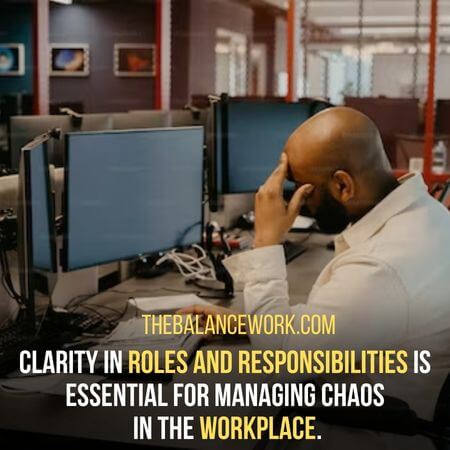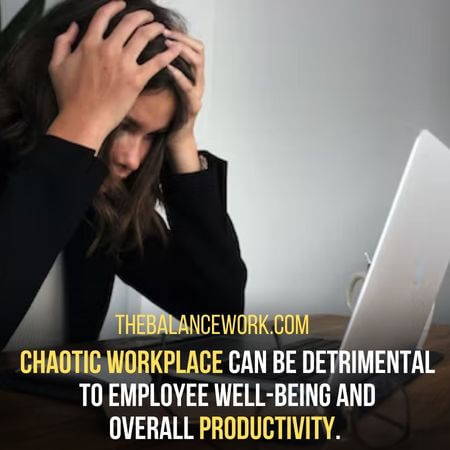How to deal with a chaotic workplace? Chaos in the workplace can negatively impact employee well-being, productivity, and overall organizational success.
This article aims to identify effective strategies for dealing with a chaotic workplace, empowering individuals to restore order and improve productivity.
5 Ways To Deal With A Chaotic Workplace?
Addressing chaos in the workplace requires proactive strategies to promote organization, clarity, and efficiency.
By implementing these strategies, employees, and organizations can effectively navigate chaotic situations and foster a more productive work environment.
1. Prioritizing and Organizing Tasks:
One of the key strategies for dealing with a chaotic workplace is prioritizing and organizing tasks.
This involves identifying the most important tasks and focusing on them first.
By establishing clear goals and deadlines, employees can effectively manage their workload and ensure that crucial tasks are completed on time.
Prioritization allows employees to allocate their time and resources efficiently.
This can reduce the feeling of being overwhelmed and enable them ke progress despite the chaos.
2. Improving Communication and Collaboration:
A lack of effective communication can contribute to workplace chaos.
To address this, organizations should focus on improving communication channels and processes.
This can include implementing regular team meetings, utilizing project management software, and encouraging open and transparent communication among team members.
Enhancing teamwork and collaboration can also manage, as it fosters a sense of unity and cooperation.
Employees can work together more effectively by Sharing information, ideas, and resources, minimizing confusion and increasing overall productivity.
3. Implementing Effective Time Management Techniques:
Effective time management is crucial for dealing with a chaotic workplace.
Organizations and employees should focus on setting realistic deadlines and managing time effectively.
This can involve creating schedules, breaking tasks into manageable steps, and utilizing productivity tools and techniques such as to-do lists and time-blocking.
By effectively managing their time, employees can prioritize tasks, allocate resources efficiently, and avoid feeling overwhelmed by the chaos.
Time management techniques provide structure and allow employees to work more efficiently, even in challenging and chaotic situations.
4. Establishing Clear Roles and Responsibilities:
Clarity in roles and responsibilities is essential for managing chaos in the workplace.

Organizations should ensure each employee has a defined role and understands their responsibilities.
This includes clearly outlining job descriptions, expectations, and reporting lines.
When employee clearly understands their roles, they can work more confidently and efficiently.
Additionally, accountability should be established to ensure that tasks are properly delegated and completed.
Clear roles and responsibilities reduce confusion, duplication of efforts, and potential conflicts.
This contributes to a more organized and streamlined work environment.
By implementing these strategies, employees, and organizations can effectively navigate chaotic workplace situations.
These strategies promote organization, communication, and clarity, enabling employees to work more efficiently and reducing the negative impacts of chaos.
Organizations need to recognize the importance of addressing chaos.
They must actively support their employees in implementing these strategies to create a more productive and harmonious work environment.
5. Stress Management and Self-Care:
Dealing with a chaotic workplace can take a toll on employees’ well-being.
To effectively manage stress and prevent burnout, it is important to prioritize stress management and practice self-care.
1. Recognizing Signs of Stress and Burnout:
Employees should be aware of the signs of stress and burnout in themselves and their colleagues.
This includes fatigue, irritability, difficulty concentrating, and decreased motivation.
Recognizing these signs allows individuals to address their well-being and seek support when needed proactively.
2. Implementing Stress Reduction Techniques:
Employees should implement stress reduction techniques to manage the pressures of a chaotic workplace.
This includes taking regular breaks throughout the day to rest and recharge.
Relaxationion techniques such as deep breathing exercises, meditation, or mindfulness can also help reduce stress levels.
Additionally, incorporating physical exercise into one’s routine and maintaining a healthy lifestyle can positively impact stress management.
3. Seeking Support and Resources:
Employees should utilize the available support and resources within the organization.
Many companies offer Employee Assistance Programs (EAP).
They provide confidential counseling and support for employees facing personal or work-related challenges.
Seeking guidance from mentors or coaches can also provide valuable insights and strategies for managing stress in a chaotic workplace.
Causes of Chaos in the Workplace
A chaotic workplace can be detrimental to employee well-being and overall productivity.

The causes of chaos in the workplace are diverse and interconnected.
They range from communication issues and unclear expectations to poor organizational structure and high-stress levels.
Recognizing these causes is the first step toward addressing and mitigating chaos:
1. Lack of Clear Communication and Direction:
Clear communication and direction are essential for a well-functioning workplace.
When communication is unclear or inconsistent, it can lead to confusion, misunderstandings, and, ultimately, chaos.
Employees may not clearly understand their roles, tasks, or goals, which can result in inefficiency and conflicts.
2. Inconsistent or Unclear Expectations:
When expectations are not clearly defined or are inconsistent, it can create confusion and chaos in the workplace.
Employees may receive conflicting instructions or not know what is expected, leading to disorganization and a lack of coordination.
3. Poor Communication Channels and Processes:
Effective communication channels and processes are crucial for smooth operations.
If communication channels are inefficient or lack proper communication processes, important information may not reach the right people promptly.
This can result in delays, misunderstandings, and chaos.
4. Inadequate Organizational Structure and Processes:
A well-designed organizational structure and efficient processes are key to maintaining order and minimizing chaos.
Inadequate organizational structure can lead to confusion about reporting lines, decision-making, and accountability.
Poor processes can result in inefficiencies, delays, and frustration among employees.
5. Lack of Defined Roles and Responsibilities:
When roles and responsibilities are unclear, it can create confusion and overlap in tasks.
Employees may not know who is responsible for what, leading to duplication of efforts or tasks being neglected.
This lack of clarity can contribute to chaos and a decrease in productivity.
6. Inefficient Workflow and Task Management:
Efficient workflow and task management are essential for maintaining order and productivity.
When workflows are inefficient, ent or tasks are not properly managed; it can lead to bottlenecks, missed deadlines, and chaos.
This can result in frustration among employees and a decrease in overall performance.
7. High Levels of Stress and Pressure
A high-stress work environment can contribute to chaos and a lack of control.
When employees are under significant pressure and stress, it can impair their ability to focus, make sound decisions, and effectively manage their tasks.
This can lead to disorganization and further exacerbate the sense of chaos.
8. Excessive Workloads and Tight Deadlines
When employees are overloaded with work or face unrealistic deadlines, it can create a chaotic work environment.
The pressure to meet tight deadlines can lead to rushed and poor-quality work, increasing the chances of errors and chaos.
9. Lack of Work-Life Balance and Support Systems
A lack of work-life balance and inadequate support systems can contribute to chaos in the workplace.
When employees cannot maintain a healthy balance between work and personal life, it can increase stress, burnout, and difficulties managing responsibilities.
Effects Of A Chaotic Workplace
A chaotic workplace significantly impacts employees, leading to various negative effects on their well-being and job performance.

Understanding these effects is crucial in recognizing the importance of addressing chaos and implementing strategies for improvement.
1. Employee Stress And Burnout:
One of the primary effects of a chaotic workplace is increased stress and burnout among employees.
The lack of clear communication, excessive workloads, tight deadlines, and poor work-life balance contribute to heightened stress levels.
The constant pressure and uncertainty can leave employees feeling overwhelmed and exhausted, leading to physical and mental health issues.
This can result in decreased motivation, decreased job satisfaction, and increased absenteeism.
B. Decreased Productivity And Efficiency:
Chaos in the workplace can have a detrimental impact on productivity and efficiency.
Employees may struggle to prioritize tasks when there is a lack of clear direction, inconsistent expectations, and inadequate organizational structure.
This struggle can lead to inefficiency and confusion. Poor communication channels and processes can hinder information flow.
This can make it challenging to collaborate and coordinate efforts effectively.
As a result, work may become disorganized, leading to delays, errors, and decreased overall productivity.
C. Negative Impact On Employee Morale And Job Satisfaction:
A chaotic workplace can significantly affect employee morale and job satisfaction.
When employees constantly face chaos, such as unclear roles and responsibilities or inconsistent expectations, it creates a sense of frustration and dissatisfaction.
The lack of support systems and work-life balance further contribute to low morale.
Employees may feel undervalued, unappreciated, and disconnected from work, decreasing engagement and motivation.
Over time, this can result in high turnover rates as employees seek a more stable and fulfilling work environment.
Overall, the effects of a chaotic workplace are far-reaching and can have significant implications for both employees and the organization.
Addressing these effects requires proactive measures to create a more organized, supportive, and productive work environment.
Conclusion:
In conclusion, dealing with a chaotic workplace requires a combination of effective strategies.
Individuals can navigate the challenges by prioritizing organization, communication, time management, role clarity, and stress management.
They can maintain their well-being, productivity, and job satisfaction in a chaotic work environment.
Last Updated on 1 month by Shahzaib Arshad
- Why Does My Boss Wink At Me? 6 Potential Reasons - October 5, 2023
- Is It Legal For Your Employer To Call Your Doctor? No, But… - October 4, 2023
- 12 Ways To Deal With A Low IQ Person - September 22, 2023
